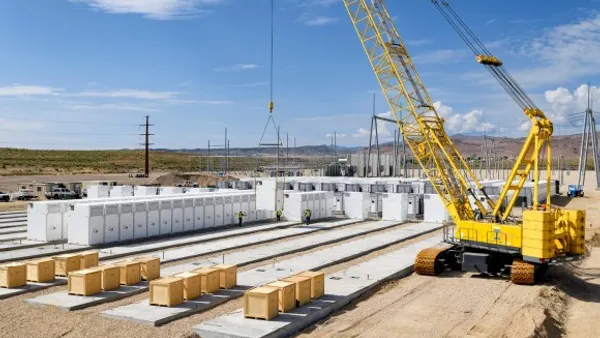Dive Brief:
- The U.S. energy storage market continued its growth streak in the third quarter of 2019, with a 93% year-over-year increase in megawatt-hours of storage deployed, but the dollar value of the market is set to explode by more than 700% over the next five years, according to the newest Wood Mackenzie U.S. Energy Storage Monitor, released Tuesday.
- WoodMac expects increased utility procurement of energy storage as well as rising interest in battery storage for resiliency during extreme events, including the California wildfires, will help propel storage deployment in the 2020s.
- But even as residential and non-residential customers in California install more behind-the-meter projects, WoodMac projects that front-of-the-meter projects like utility-scale storage will grow even faster.
Dive Insight:
Wood Mackenzie's U.S. Energy Storage Monitor estimates that the annual value of the U.S. market will grow about 32% from $489 million in 2018 to $645 million in 2019, before surging 737% to nearly $5.4 billion by 2024.
The 2018 value is roughly evenly divided between front-of-the-meter utility projects and behind-the-meter, residential and non-residential projects. In 2019, residential behind-the-meter storage is capturing a larger share than the other two segments. But throughout the 2020s, front-of-the-meter projects will increasingly grow to become a clear majority of the market, Wood Mackenzie says.
"[Front-of-the-meter] deployments are set to surge in 2020, followed by a dramatic spike in 2021 as numerous large-scale deployments that are currently planned or contracted begin to come online and continue through 2024 at a heightened pace," according to the report's executive summary.
For example, Massachusetts, the state with the most front-of-the-meter deployments in Q3 2019, in May passed a Clean Peak Energy Standard that calls for 1 GW of energy storage by 2025, which is expected to lead to even more utility-scale projects in that state.
The projection that front-of-the-meter projects will take a dominating share of the storage market "is a signal of a surging [front-of-the-meter market] rather than any indictment on the behind-the-meter market," WoodMac head of energy storage Daniel Finn-Foley told Utility Dive in an email.
"Favorable elements of the clean peak standard in Massachusetts, the California Public Utilities Commission ordering GWs of new capacity in southern California (much of which will be storage), surging interest in interconnection queues, all are pointing to [a front-of-the-meter] market set to beat expectations and accelerate in regulated and deregulated markets alike," Finn-Foley said.
Last month, California regulators directed state utilities and community choice aggregators (CCAs) to procure 3,300 MW of clean energy by 2023, including hybrid solar-plus-storage systems and standalone storage projects.
California led the third quarter in both residential and non-residential behind-the-meter deployments, though it's too early to include effects of the state's recent public safety power shutoffs.
Those outages are expected to drive higher residential battery sales in 2020, according to WoodMac, as reported by GreenTech Media, and they also have raised the urgency for California CCAs and municipal utilities to solicit behind-the-meter storage projects for both residential and non-residential customers.












